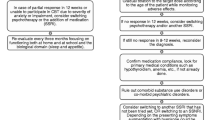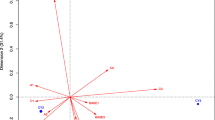Abstract
This study aimed to examine parents’ perceptions of established treatments, including cognitive behaviour therapy (CBT) and selective serotonin reuptake inhibitors (SSRIs), relative to novel treatments of d-cycloserine (DCS) and attention bias modification (ABM) augmented CBT to determine if novel treatments are perceived as more or less favorable than established treatments. Participants included parents of children with a specific phobia, enrolled in one of two randomized controlled trials of either one-session augmented DCS (n = 38, Gold Coast) or ABM augmented one-session treatment (n = 34, Brisbane), as well as parents from a community sample (n = 38). Parents of children with a specific phobia perceived CBT most favorably. There was no difference between the sites on perceptions of ABM. However, parents of children enrolled in the DCS trial perceived DCS more favorably than parents of children enrolled in the ABM trial and the community sample. These results demonstrate parents’ greater acceptance of psychological treatments over pharmacological treatments for the treatment of childhood phobias, highlighting the importance of educating parents to novel treatments.
Similar content being viewed by others
References
Davis TE, Ollendick TH (2005) Empirically supported treatments for specific phobia in children: do efficacious treatments address the components of a phobic response? Clin Psychol Sci Pract 12:144–160
Essau CA, Conradt J, Petermann F (2000) Frequency, comorbidity, and psychosocial impairment of specific phobia in adolescents. J Clin Child Psychol 29:221–223
Fisher PH, Tobkes JL, Kotcher L, Masia-Warner C (2006) Psychosocial and pharmacological treatment for pediatric anxiety disorders. Expert Rev Neurother 6:1707–1719
Ollendick TH, King NJ, Muris P (2002) Fears and phobias in children: phenomenology, epidemiology, and aetiology. Child Adolesc Ment Health 7:98–106
Silverman WK, Pina AA, Viswesvaran C (2008) Evidence-based psychosocial treatments for phobic and anxiety disorders in children and adolescents. J Clin Child Adolesc Psychol 37:105–130
Gregory AM, Caspi A, Moffitt TE, Koenen K, Ely TC, Poulton R (2007) Juvenile mental health histories of adults with anxiety disorders. Am J Psychiatry 164:301–308
Cartwright-Hatton S, Roberts C, Chitsabesan P, Fothergill C, Harrington R (2004) Systematic review of the efficacy of cognitive behavior therapies for childhood and adolescent anxiety disorders. Br J Clin Psychol 43:421–436
Seligman LD, Ollendick TH (2011) Cognitive behavioral therapy for anxiety disorders in youth. Child Adolesc Psychiatr Clin 20:217–238
Davis TE, Ollendick TH, Öst LG (2009) Intensive treatment of specific phobias in children and adolescents. Cogn Behav Pract 16:294–303
Ollendick TH, Öst LG, Reuterskiold L, Costa N, Cederlund R, Sirbu C et al (2009) One-session treatment of specific phobia in youth: a randomized clinical trial in the United States and Sweden. J Consult Clin Psychol 77:504–516
Öst LG (1989) One-session treatment for specific phobias. Behav Res Ther 27:1–7
Öst LG, Svensson L, Hellstrom K, Lindwall R (2001) One-session treatment of specific phobias in youths: a randomized clinical trial. J Consult Clin Psychol 69:814–824
Hofmann SG, Sawyer AT, Korte KJ, Smits JAJ (2009) Is it beneficial to add pharmacotherapy to cognitive–behavioral therapy when treating anxiety disorders? A meta-analytic review. Int J Cogn Ther 2:160–175
Kendall PC (1994) Treating anxiety disorders in children: results of a randomized clinical trial. J Consult Clin Psyc 62:100–110
Kendall P, Flannery-Schroeder E, Panichelli-Mindel S, Southam-Gerow M, Henin A, Warman M (1997) Therapy for youth with anxiety disorders: a second randomized clinical trial. J Consult Clin Psychol 65:366–380
Amir N, Beard C, Burns M, Bomyea J (2009) Attention modification program in individuals with generalized anxiety disorder. J Abnorm Psychol 118:28–33
Amir N, Beard C, Taylor CT, Klumpp H, Elias J, Burns M et al (2009) Attention training in individuals with generalized social phobia: a randomized controlled trial. J Consult Clin Psychol 77:961–973
Bar-Haim Y (2010) Research review: attention bias modification (ABM): A novel treatment for anxiety disorders. J Child Psychol Psychiatry 51:859–870
Otto MW, Tolin DF, Simon NM, Pearlson GD, Basden S, Meunier SA et al (2009) The efficacy of d-cycloserine for enhancing response to cognitive–behavior therapy for panic disorder. Biol Psychiatry 67:365–370
Eldar S, Apter A, Lotan D, Perez-Edgar K, Naim R, Fox NA et al (2012) Attention bias modification treatment for pediatric anxiety disorders: a randomized control trial. Am J Psychiatry 169:213–230
Farrell LJ, Waters AM, Boschen MJ, Hattingh L, McConnell H, Milliner EL et al (2013) Difficult-to-treat pediatric obsessive-compulsive disorder: feasibility and preliminary results of a randomized pilot trial of d-cycloserine-augmented behaviour therapy. Depress Anxiety 30:723–731
Waters AM, Farrell LJ, Zimmer-Gembeck MJ, Milliner EL, Tiralongo E, Donovan CL et al (2014) Augmenting one-session treatment of children’s specific phobias with attention training to positive stimuli. Behav Res Ther 62:107–119
Farrell LJ, Waters AM, Milliner EL, Zimmer-Gembeck M, McConnell H, Tiralongo E et al (2013) Paper presented at the 7th world congress of behavioral and cognitive therapies. Lima, Peru
Cowart MJW, Ollendick TH (2011) Attention training in socially anxious children: a multiple baseline design analysis. J Anxiety Disord 25:972–977
Levant R (2005) Report of the 2005 presidential task force on evidence based practice. American Psychological Association, Washington
Kazdin AE (1980) Acceptability of alternative treatments for deviant child behavior. J Appl Behav Anal 13:259–273
Gage JD, Wilson LJ (2000) Acceptability of attention-deficit/hyperactivity disorder interventions: a comparison of parents. J Atten Disord 4:174–182
Whalen CK, Henker B (1991) Therapies for hyperactive children: comparisons, combinations, and compromises. J Consult Clin Psychol 59:126–137
Krain AL, Kendall PC, Power TJ (2005) The role of treatment acceptability in the initiation of treatment for ADHD. J Atten Disord 9:425–434
Cross-Clavert S, Johnston C (1990) Acceptability of treatments for child behavior problems: issues and implications for future research. J Clin Child Psychol 19:61–74
Svensson L, Larsson A, Öst LG (2002) How children experience brief-exposure treatment of specific phobias. J Clin Adolesc Psychol 31:80–89
Brown AM, Deacon BJ, Abramowitz JS, Dammann J, Whiteside SP (2007) Parents’ perceptions of pharmacological and cognitive–behavioral treatments for childhood anxiety disorders. Behav Res Ther 45:810–828
Morrissey-Kane E, Prinz RJ (1999) Engagement in child and adolescent treatment: the role of parental cognitions and attributions. Clin Child Fam Psychol Rev 2:183–189
Miller DL, Kelley ML (1992) Treatment acceptability. Child Fam Behav Ther 14:11–23
Liu C, Robin AL, Brenner S, Eastman J (1991) Social acceptability of methylphenidate and behavior modification for treating attention deficit hyperactivity disorder. Pediatrics 88:560–565
Chavira DA, Stein MB, Bailey K, Stein MT (2003) Parental opinions regarding treatment for social anxiety disorder in youth. Dev Behav Pediatr 24:315–322
Deacon BJ, Abramowitz S (2005) Patients’ perceptions of pharmacological and cognitive–behavioral treatments for anxiety disorders. Behav Ther 36:139–145
Wagner AW, Bystritsky A, Russo JE, Craske MG, Sherbourne CD, Stein MB et al (2005) Beliefs about psychotropic medication and psychotherapy among primary care patients with anxiety disorders. Depress Anxiety 21:99–105
Silverman WK, Albano AM (1996) The anxiety disorders interview schedule for DSM-IV-child and parent versions. Oxford University Press, London
Walker J, Vincent N, Furer P, Cox B, Kjernisted K (1999) Treatment preference in hypochondriasis. J Behav Ther Exp Psychiatry 30:251–258
Cronbach LJ (1951) Coefficient alpha and the internal structure of tests. Psychometrika 16:297–334
Nauta MH, Scholing A, Rapee RM, Abbott M, Spence SH, Waters A (2004) A parent-report measure of children’s anxiety. Behav Res Ther 42:813–839
Huynh H, Feldt LS (1976) Estimation of the box correction for degrees of freedom from sample data in a randomized block and split-plot designs. J Educ Stat 1:69–82
Author information
Authors and Affiliations
Corresponding author
Appendix: Treatment Perceptions Questionnaire: Modified DCS and ABM Sub-scales
Appendix: Treatment Perceptions Questionnaire: Modified DCS and ABM Sub-scales
Directions: This questionnaire asks about parents’ perceptions of how acceptable different treatments are for child anxiety disorders. Please read the treatment descriptions below and answer the questions that follow.
3. Novel Treatment: Antibiotic Medication plus CBT
Advantages | Disadvantages |
|---|---|
(a) Administered in a low dose and only before a therapy session | (a) As with all medications, DCS may have side effects, and should not be given if pregnant |
(b) Relatively safe compared to other drugs, given it is an antibiotic | (b) It is a new treatment, so currently we do not know a lot about how exactly it works |
(c) Evidence suggests it may achieve therapy outcomes faster. | |
(d) Evidence suggests it enhances CBT outcomes |
d-cycloserine (DCS) is an antibiotic drug, recently found to improve CBT when given prior to behavior therapy. DCS does not reduce anxiety, but enhances learning and memory during and after therapy. Specifically, DCS enhances the transmission of GABA in the brain, a chemical that helps us to learn.
Duration of Treatment
Treatment involves the standard CBT course of therapy (i.e., 12–16 sessions), and DCS is given before or after each session.
4. Novel Treatment: Attention Bias Modification Training (ABMT) plus CBT
Advantages | Disadvantages |
|---|---|
(a) Inexpensive and easy to use | (a) An additional task on top of CBT to complete |
(b) No known side effects | (b) It is a new treatment, so currently we do not know a lot about how exactly it works |
(c) Children may find a computer task interesting (d) Evidence suggests it enhances CBT outcomes |
Attention Bias Modification training was developed to help overcome problems of attention to threat which occurs with anxiety. Computer-based exercises are used to train individuals to pay attention either towards threat or away from threat to assist in overcoming anxiety.
Duration of Treatment
Treatment involves the standard CBT course of therapy (i.e., 12–16 sessions), and usually one session of computer training prior to each session.
Rights and permissions
About this article
Cite this article
Roberts, C.L., Farrell, L.J., Waters, A.M. et al. Parents’ Perceptions of Novel Treatments for Child and Adolescent Specific Phobia and Anxiety Disorders. Child Psychiatry Hum Dev 47, 459–471 (2016). https://doi.org/10.1007/s10578-015-0579-2
Published:
Issue Date:
DOI: https://doi.org/10.1007/s10578-015-0579-2




